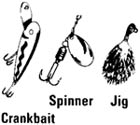|
|
|
|
|
Consumer Guides |
Government Guides |
Consumer News |
Consumer Guides
Index
Consumer Guides
Home
Submit Government Guide
Copywriting Services
Adoption
Biology - Human Genome Project
Cosmetic Surgery and Financing
Disaster Help
Guide to help Rebuild Your Home
Earthquakes -Preparation, Survival
Drugs
Financial
Currency: Buying, Selling and Redeeming
Stock Market Basics Government Links - Federal, State, Local Homeland Security Health Health InsuranceMarriage
Sleep and Marriage StudyPatents, Trademarks, Copyrights
Private Jets Cessna LearReal Estate
Financing Energy Efficient Homes
Tax Hike - Expiring Bush Tax Cuts
Technology
Travel
Tips For Women Traveling Alone
Other Online Guides
Disclaimer
Fishing Is
Fun for Everyone
It’s Easy to Learn How
|
Hook, Line, and Sinker Now that you’ve learned your knots and how to cast, you are ready to set up your rod with hook, line, and sinker. Cut off the casting plug and tie on a hook using either the Palomar or Improved Clinch Knot. Attach 1 or 2 sinkers or fishing weights to the line, 6 to 12 inches above the hook. This weight will keep your bait or lure down in the water and will help swing it away from shore. 
For a beginner, live natural bait such as worms,
minnows, crickets, and other insects is a good option. A few shovels
full of dirt in your backyard will often provide enough worms. If you
can’t dig your own, you can find them in a sporting goods or bait
shop. If you want to use minnows, catch them in or near the waters you want to fish. This prevents bringing new diseases or fish species into a river, lake, or stream. Return leftover bait fish to where you caught them.  
Fishing lures— crankbaits, spoons, jigs, spinners, flies, and soft lures like plastic worms— are excellent artificial baits but may require special fishing techniques. This is called “working” the lure. A bobber lets you know when fish are biting,
because it moves up and down in the water as fish nibble at the bait.
You can make a bobber from a cork, or buy an inexpensive plastic one.
The narrow cork and quill bobber made from balsa wood or plastic is more
sensitive to fish movement. Most bobbers attach to fishing line with a spring clip and move up and down the line easily, depending on how deep you want to fish the bait. |
|
What about Accessories? A tackle box will store the variety of lures, hooks, snap swivels, weights, tools like pliers and wire cutters, and other gear. You might also need a live bait container (such as a minnow bucket or a worm box), a stringer or an ice chest to keep your catch fresh, a landing net, rod- and- reel cases and a first- aid kit for minor emergencies. Other handy items include a scaler, hook disgorger, tape measure and scale, and a filet knife. |
|
Table of Contents What kind of tackle can I use?
Source: U. S. Fish & Wildlife
Service
|
Hot Link:
iTunes Gospel Rock Music
![]()
Rock version of
the Lord's Prayer
and more...
Presence
a unique find...
www.mycrossbridge.org



